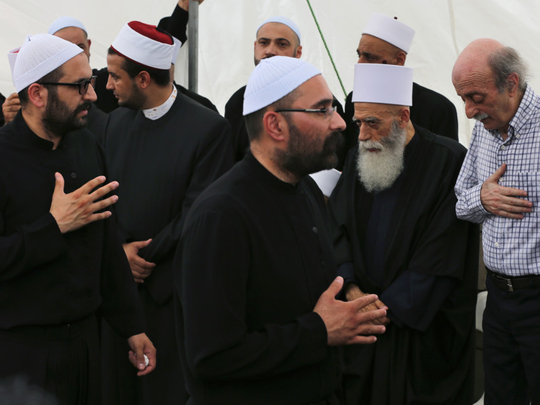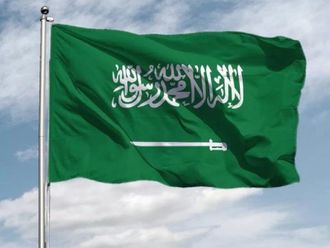
Beirut: Fiercely cohesive, impeccably secretive, and ferociously loyal to each other, the Druze, who number about a million souls throughout the world, are a monotheistic religious community that developed a separate spiritual scriptures known as the Epistles of Widsom even if they are part of the monotheistic world. Although the Epistles incorporates texts drawn from Judaism, Christianity and Islam, the Druze faith also relies on contemporary Greek philosophy, including the teachings of Plato, Aristotle, and Socrates. Moreover, there are supplemental texts such as the Epistles of India, which draw on mysticism drawn from the Sub-Continent, led by Hindu and Buddhist traditions.
Given the secrecy that surrounds the faith, little is actually known about Druze origins, even if scholars concede that the bulk of all teachings attributed to its members arose out of Isma‘ilism, a branch of Shiism whose adherents are also known as Seveners because they accept Isma‘il ibn Ja‘afar as the seventh and last spiritual Imam after Ja‘afar Al Sadiq. Propagation of the tenets of the faith began in Cairo around 1017, led by one Hamzah ibn ‘Ali, though Hamzah’s subordinate, Muhammad Al Darazi gave the group its appellation.
Darazi was assassinated in 1018 allegedly for his teachings, which were deemed insolent by some followers, even if few details exist to corroborate legendary tales. Suffice it to say that historians rarely mention the word “Druze” and, equally important, it hardly appears in the Epistle. Rather, religious texts use the word Muwahhidun (Unitarian) though Benjamin of Tudela, a Jewish traveler who passed through Lebanon in or around 1165, referred to the Druzes by name, and placed them in the area as “mountain dwellers, monotheists, who believe in the ‘soul’s eternity’ as well as reincarnation.”
Why the community left Egypt and settled in Lebanon and Syria is also unknown especially when various sources confirm that Hamza was on good terms with the Fatimid caliph Al Hakim, known for his relative tolerance. Over time, Al Hakim became a central figure in the Druze faith, with some scholars affirming that the ruler believed “he was not only the divinely appointed religio-political leader but also the cosmic intellect linking God with creation.” Others advanced the notion that Al Hakim was “perceived as the manifestation and the reincarnation of God or presumably the image of God.” Such interpretations led to confusion as Darazi’s preachings stood in contrast to Al Hakim’s views that, naturally, led the latter to condemn the former. Whether palace intrigues led to Al Hakim’s presumed assassination was impossible to know, although the Druze believe he went into occultation, leaving the care of the community to a new leader, Al Muqtana Baha Al Deen.
Al Hakim’s underage successor, ‘Ali Al Zahir, failed to impose himself, which gave the regent Sitt Al Mulk immense powers, which the latter used to destroy the movement in 1021. Baha Al Deen endured for seven years when the Druze faced extreme persecution caught between various political allegiances that, in time, led to their eviction from Alexandria. After tens of thousands of Druze were slaughtered by the Fatimid army, including 5,000 leaders in Antioch and Aleppo, the community retreated to the safety of the Lebanese mountains and in Syria starting in 1035. In 1043 Baha Al Deen declared that the sect would no longer accept new pledges, thereby closing all proselytization efforts, which meant that one could not convert into the faith.
Under Crusader rule in Syria (1099–1291), the Druze gained notoriety as powerful warriors serving Muslim rulers in Damascus against Western intruders. The military experience thus gained served the Druze well after they offered their services to the Mamluks of Egypt (1250–1516), especially as Cairo expanded its realm throughout the Syrian coast. This was also the period when leading families emerged, the Arslan and the Ma‘an, before feudal conflicts polarized the community. In the event, entire towns pledged allegiances to one or the other of the nascent families, which build fierce loyalties that also earned the Druze respect among Sunni Muslim caliphs.
Family Feuds and the Ottomans
By the 12th century, the Ma‘an fell victim to clashes that pitted Sunni Arab rulers and Ottoman intruders, caught once again in classic regional power struggles. Ottoman attacks led to Druze rebellions starting in the 16th century that, in turn, encouraged the Turkish Sultans to annihilate many Druze who refused subordination. This led Constantinople to introduce an arrangement whereby different districts of Mount Lebanon were granted fiscal freedoms to a region’s ruler in exchange of law and order, the collection of taxes, and other governance duties. Consequently, the rulers would be loyal to the Sultans, as the Ottomans honed feudalism without the burden of intrusion into local affairs. The Ma‘ans survived and prospered especially under the Amir FakhrAl Deen II—perhaps the first Druze leader with a keen sense of affiliation to Lebanon—who, as later events illustrated, became one of the first inhabitants that developed a sense of nationalism.
FakhrAl Deen ruled over large sways of land, including Tadmur (Palmyra)—where he build a huge castle that is still standing—and BeitAl Deene—today’s a presidential summer residence in Lebanon—though his popularity earned him Ottoman scorn. He fled to Tuscany in 1613, signed commercial treaties with the Medicis that included secret military clauses, and fell victim to the Sultan’s revenge. In 1618, FakhrAl Deen defended Lebanon but was eventually captured, taken to Turkey, and executed in 1635. What the Amir’s resistance showed, however, was that genuine Lebanese opposition could muster the courage to reject submission to occupation that, in time, led to the independence of the 1920s.
Sadly, old intra-family feuds surfaced in the mid-1650s and seldom ended ever since. The Ma‘an era closed in the later 1600s, as a new family emerged, the Shihabs, which were destined to play one of the most critical roles in Lebanese history.
Shihab Dynasty
A small Hijazi tribe that migrated north, the Shihab aligned themselves with the powerful Ma‘ans and, at the end of the 17th century (1697) succeeded them in the feudal leadership in Lebanon. Sunni Muslims, the Shihabs were tolerant towards their Druze neighbors who, naturally, were the majority. By the middle of the 19th century, the Shihabs produced several illustrious governors, including the Amir Bashir Shihab II (1788–1840) who, by universal acknowledgment, was the most powerful feudal lord in Lebanese history. Bashir was a crypto-Christian and was probably raised in a Maronite home. In 1799, Napoleon Bonaparte solicited Amir Bashir’s assistance during his campaign against the Ottomans in Syria, where Ibrahim Pasha, the son of the viceroy of Egypt, Muhammad ‘Ali Pasha, scored clear victories. When Ibrahim turned against Lebanese minorities and sought to draft young men from various communities into the Ottoman army, one of the long established principles of semi-independence life in Mount Lebanon was violated, which led to a general uprising against Egyptian/Ottoman rule but that also rekindled internecine warfare.
Civil War of 1860
The Druzes and their Christian Maronite neighbors, who co-habited on friendly terms until the 1840s, experienced intense rivalries that culminated in the 1860 Civil War. After the Shihab dynasty converted to Christianity, the Druze were caught in the Catholic vs. Protestant feuds, as feudal leaders lost most of their political powers. Some Druze leaders believed that they would only survive and prosper once again if they formed an alliance with Britain and allow Protestant missionaries to enter Mount Lebanon that, naturally, created tensions between them and Catholic Maronites.
Between 1840 and 1860, the Maronites and Druzes clashed as the former sought independence from all occupiers, which led to mayhem. Massacres followed in Dayr Al Qamar, Zahle, Hasbaya and even in Damascus, as Maronites were systematically defeated. Both France and Britain deployed troops not necessarily to help one community against the other but to fight a proxy war against the Ottomans in a remote part of the world. In the event, and even if London did not wish to dismember its Ottoman rival’s holdings in the Arab World, European military interventions in Lebanon and Syria pressured the Turks to recalibrate their treatment of minorities. As a direct result of the 1860 troubles, the Ottomans granted Lebanon local autonomy, under Turkified but Christian Armenian governors.
Rebellion in Syria
Notwithstanding the imposed peace, Druze elements rejected Ottoman injustices and rebelled against Constantinople starting in May 1909. The Al Atrash family led the uprising, reminiscent of similar events in 2011, and while they arose after hefty taxes were imposed followed by forced conscriptions into the Ottoman Army, they nevertheless were motivated by the quest for freedom. The 1909 rebellion ended in brutal suppression of the Druze by General Sami Pasha Al Farouqi, significant depopulation of the Hawran region and execution of scores of Druze leaders in 1910. In the outcome of the revolt, 2,000 Druze were killed, a similar number wounded and hundreds of Druze fighters imprisoned.
Independence and Minority Guarantees
The Druze earned their official recognition as separate religious communities in Lebanon and Syria, with their own religious court systems, which proved effective. Remarkably, they blended in even if they retained their fierce senses of resistance against occupying powers. Damascus tolerated their significant presence in the Jabal Al Druze, in the southwestern corner of the country near the capital, although the community also maintained a significant presence in the Golan Heights that were occupied by Israel in 1967. Critics of the Ba‘ath regime insisted that one of the reasons why Syria was not in a hurry to liberate its occupied lands was due to the fact that these lands belonged to the Druze, although members of the community played important roles in the country’s political life. Beyond the Al Atrash family, many of whom joined the 1925-1927 Syrian Revolution against the French, the Druze served in the Syrian Arab Army though ties were almost always difficult especially after the Ba‘athists introduced their “Syrianization” policies across the board.
In Lebanon, the Druze community fared much better as one the Arslan family scions played a key role in the independence movement. The Amir Majid Arslan served as the country’s first defense minister and even if some feudal traditions lingered, the Druze seldom lost their attachments to the land. To be sure, and like most other Lebanese groups, the Druze favored pan-Arabism and sided with various Palestinian resistance movements, but in the aftermath of the 1975-1990 Civil War, the community experience a cathartic transformation.
Before and during the war, the community supported the Progressive Socialist Party that was formed by Kamal Junblatt, a mystical nationalist who descended from the feudal mountainous town of Mukhtara. In the frenzy that followed the chaos of the bloody conflict, Junblatt fought alongside other leftist and Palestinian parties against the Lebanese Front that was mainly constituted by Christians, whose leaders aligned with Hafez Al Assad of Syria. Kamal Junblatt was assassinated on 16 March 1977, most probably on Al Assad’s orders, only to be succeeded by his son, Walid. Maronite-Druze ties went from bad to worse as entire Christian villages were emptied of their inhabitants during the civil war.
To his credit, Walid Junblatt accepted diminishing Druze demographic conditions and opted to reconcile with the Maronites, which led to an August 2001 entente with Cardinal Mar Nasrallah Boutros Sfeir, who toured the predominantly Druze Chouf region of Mount Lebanon and visited Mukhtara, the ancestral stronghold of the Druze leader. The tumultuous reception that Sfeir received not only “signified a historic reconciliation between Maronites and Druze, who fought a bloody war in 1983–1984, but underscored the fact that the banner of Lebanese sovereignty had broad multi-confessional appeal and was a cornerstone for the 2005 Cedar Revolution.”
Yet, and true to his creed’s survival instincts, Junblatt’s post-2005 positions oscillated sharply, as Walid accused Damascus of being behind his father’s assassination, sided with the March 14 Movement, before he offered a mea culpa, visited Damascus to meet with Bashar Al Assad and, after 2011, turned against the Syrian regime once again.
Taqiyya and Philosophy
Like many Shiite Muslims, the Druze practice taqiyya, which allows a faithful individual to conceal or disguise one’s their beliefs as necessary. Of course, this adaptation occurred to avoid persecution, although Druze philosophies and beliefs certainly allow members of the community to interpret their secretive theology in the most peculiar way possible. While religious scriptures are valuable, so is the mind and the search for truthfulness, which means that the Druze follow theophany, a “belief that God manifests himself in a human form and in reincarnation or the transmigration of the soul.” Believers are persuaded that at the end of the cycle of rebirth, which is achieved through successive reincarnations, the soul is united with the Cosmic Mind (Al ‘Aqal Al Kulli).
There are, thus, the Juhal, those who are intellectually and spiritually weak, ands the ‘Uqal who reached certain levels of cohesiveness and understandings. In the absence of a religious hierarchy, the Druze fall back on steep traditions, including the clothes that both men and women wear, though the impact of cohabitation with Christians and other minorities in the Levant left a certain impact, which is the chief reason why the community now fields a Shaikh Al ʻAql, a spiritual leader who represents the Druze in Lebanon’s checkered ethnic and political mosaic.












